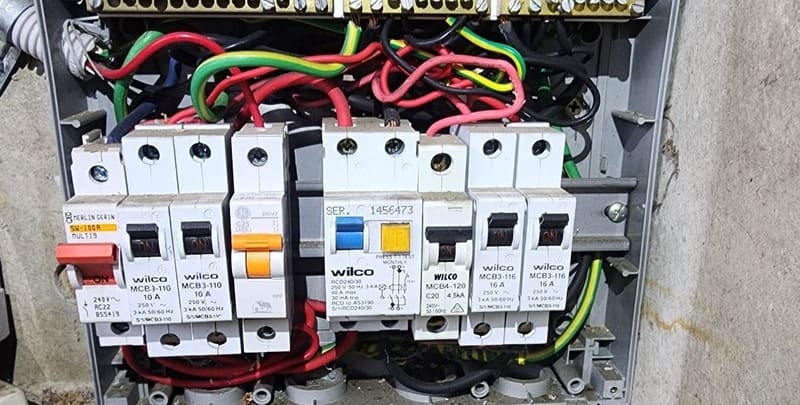
5 Signs That a Circuit Breaker Needs Replacing
Circuit breakers are the unsung heroes of your home's electrical system. These seemingly inconspicuous devices protect your family and property from the ever-present risks of electrical overloads and potentially devastating fires.
However, like all mechanical components, circuit breakers are not immortal. Over time, they can develop issues that compromise their functionality and safety. Recognising the signs of a failing circuit breaker is not just a matter of convenience; it’s a crucial aspect of ensuring your electrical system’s continued safety and reliability.
In this comprehensive guide, we will delve into the world of circuit breakers and explore five unmistakable indicators that serve as a clear signal – sometimes even a warning – that it’s time to consider replacing your circuit breaker.
By the end of this journey, you will have the skills to safeguard your home, appliances, and loved ones against the potential hazards a malfunctioning circuit breaker poses.
So, let’s embark on this exploration and discover the five telltale signs that your circuit breaker needs replacement, ensuring the electrical safety and peace of mind you deserve.
Sign 1: Frequent Circuit Tripping
Circuit tripping, a familiar term for many homeowners, is an essential safety feature of your electrical system. It acts as a vigilant guardian, designed to disconnect power when it detects an excessive load or a short circuit within your electrical circuits.
Circuit tripping primarily aims to prevent overheating, electrical fires, and equipment damage. It serves as your first line of defence against electrical calamities.
Why is Frequent Tripping a Red Flag?
Imagine a scenario where your circuit breaker begins to trip regularly. You often find yourself in the dark or dealing with a non-functional appliance instead of enjoying the reliable power supply you’re accustomed to.
This repetitive occurrence of electrical circuit breaker tripping should raise an immediate red flag and prompt a closer inspection of your circuit breaker.
Real-World Examples and Scenarios
Frequent tripping can manifest in various real-world scenarios. For instance, plugging too much power from multiple high-power appliances into the same circuit can cause overloads, leading to recurrent tripping.
Picture the inconvenience of your lights flickering off every time you use the microwave or hairdryer. In some cases, circuit tripping may also be a symptom of a failing circuit breaker. The breaker’s internal components may no longer function correctly, making it hypersensitive and prone to tripping even with moderate electrical loads.
Such frequent tripping is not only an inconvenience but also a potential hazard. It’s a clear sign that your circuit breaker is struggling to maintain a safe and reliable electrical supply in your home.
In the following sections, we’ll explore more warning signs to help you determine whether it’s time to replace your circuit breaker to ensure your electrical system’s uninterrupted power and safety.

Sign 2: Overheating
Circuit breaker overheating is another concerning sign that merits close attention. It’s precisely what it sounds like the circuit breaker becomes excessively hot during its operation.
But why is this a problem, and what could be causing it?
Potential Causes of Overheating
Overheating can occur for various reasons, each of which poses a risk to your electrical system. Some common culprits include:
- Loose or corroded connections: Connections within your circuit breaker box should be secure and corrosion-free. Loose or corroded connections can introduce resistance and generate excess heat.
- Deteriorating insulation: The wires and components inside the circuit breaker box are insulated to prevent electrical contact. If this insulation is worn or damaged, it can result in excessive heat generation.
- Circuit overloading: Overloading a circuit by connecting too many high-power appliances or devices can cause overheating. It strains the circuit breaker, making it work harder and generate heat.
The Dangers of Overheating
Understanding why overheating is a concern is crucial. When a circuit breaker overheats, it’s no longer operating within its designed temperature range. It compromises the circuit breaker’s functionality and, even more alarmingly, poses serious safety risks.
The risks and dangers include:
- Electrical fires: Overheating is a precursor to electrical fires. The excessive heat can ignite nearby combustible materials or even cause sparks within the breaker box, potentially leading to a catastrophic fire.
- Reduced breaker lifespan: Overheating places undue stress on the circuit breaker’s components, reducing their lifespan. A breaker that overheats frequently is more likely to fail, leaving your electrical system vulnerable.
Given the potential hazards of circuit breaker overheating, promptly recognising and addressing this sign is essential. In the following sections, we’ll explore more telltale indicators that may suggest it’s time to replace your circuit breaker to maintain a safe and efficient electrical system in your home.
Sign 3: Burn Marks or Scorching
An alarming and visible sign of trouble in your electrical system is the presence of burn marks or scorching on your circuit breaker.
These marks typically manifest as dark, discoloured areas on the breaker’s surface, resembling a small fire’s aftermath. But what do these marks signify, and why are they a matter of concern?
What Do Burn Marks Indicate?
Burn marks on a circuit breaker indicate electrical problems within your system. They are the aftermath of localised overheating within the circuit breaker panel or box.
Typically, these marks occur due to loose or corroded components and connections within the box, introducing resistance and causing excessive heat generation.
Burn marks aren’t just a cosmetic issue; they’re a visible testament to the fact that the wiring in your circuit breaker is not functioning as it should. Someone has compromised the breaker’s ability to protect your home’s electrical system.
Safety Risks
Burn marks on an electrical panel of a circuit breaker go beyond aesthetics; they are a warning of impending danger. These marks are a precursor to electrical shorts, leading to electrical fires or even electrical shock if left unattended.
Emphasising the safety risks associated with burn marks is crucial. Ignoring them can have dire consequences. In the upcoming sections, we’ll explore further signs that signal a malfunctioning circuit breaker and investigate the necessary steps to ensure your home’s electrical system remains safe and dependable.

Sign 4: Electrical Shocks
Experiencing an electrical shock in your own home is a truly alarming and potentially dangerous situation. It is one of the most concerning signs that a circuit breaker may malfunction.
Risks and Consequences
Electrical shocks occur when electrical current flows through your body, typically caused by a failure in the circuit breaker to disconnect power as it should.
The consequences of electrical shocks can be severe and include:
- Pain and discomfort: Electrical shocks can be painful, and even mild surprises can be uncomfortable.
- Injury: Prolonged exposure to electrical shocks can result in injury, and severe shocks can be life-threatening.
- Electrocution: In the worst-case scenario, electrical shocks can lead to electrocution, which can be fatal.
Experiencing electrical shocks in your home indicates something is wrong with your electrical system, and it’s essential to address this issue promptly to prevent further harm.
What to Do If You Experience an Electrical Shock
If you ever experience an electrical shock, the immediate priority is to disconnect power. It can often be done by turning off the circuit breaker associated with where the shock occurred. Here are the steps to take:
- Ensure your safety: If you can do so safely, disconnect the power source or unplug the device causing the shock.
- Call for help: If someone is injured or the situation is uncontrolled, contact emergency services.
- Seek professional assistance: After addressing immediate safety concerns, it’s essential to call a professional electrician to diagnose and rectify the issue. Only attempt to fix the problem if you have the necessary expertise.
Electrical shocks are not to be taken lightly, and they indicate a serious problem within your electrical system.
In the following sections, we’ll explore additional signs to help you determine if it’s time to replace your circuit breaker and maintain a safe and reliable electrical system in your home.
Sign 5: Age and Outdated Breakers
Circuit breakers, like any other electrical component, have a finite lifespan. The design provides reliable protection for a particular duration of time.
As they age, their performance and reliability can diminish, making it crucial to assess the age of your circuit breaker.
Why Older Breakers May Need Replacement
As circuit breakers age, their internal components may deteriorate. This deterioration can result in several issues, including:
- Reduced responsiveness: Older breakers may become less responsive, leading to delays in tripping when needed. It can jeopardise the safety of your electrical system.
- Increased failure risk: Aged circuit breakers are more prone to failure, which can result in overloads and electrical hazards.
- Obsolete technology: Older breakers may need more modern safety features and technologies present in newer models.
Newer, More Efficient Options
In recent years, circuit breaker technology has advanced significantly. Designers have made modern circuit breakers more efficient, incorporating improved safety mechanisms and compatibility with newer technologies. Upgrading to a more contemporary or new circuit breaker can enhance your electrical system’s overall protection and performance.
While a well-maintained, replaced and periodically inspected older circuit breaker can continue to function effectively, assessing its age and considering an upgrade is a wise step to ensure your home’s electrical safety and the electrical system’s reliability.
The lifespan of a circuit breaker can vary depending on factors such as the manufacturer and usage. Still, if you have an older breaker and are experiencing any of the signs mentioned earlier, it’s a strong indication that it’s time to consider a replacement.
In the final section of this guide, we’ll summarise the five signs that signal the need for circuit breaker replacement.
Additional Tips for Circuit Breaker Maintenance
Beyond recognising the signs of failing circuit breaker trips, however, you can take steps to extend the lifespan and effectiveness of your circuit breakers.
Here are some quick maintenance tips:
- Regularly inspect your breaker panel or box for signs of wear, burn marks, or loose connections.
- Keep the area around your breaker box clear and accessible.
- Avoid overloading circuits by distributing power-hungry appliances across different courses.
- Consider upgrading to newer, more efficient circuit breakers.
- Professional inspection, repair and replacement are essential for peace of mind and safety.
Inspect Your Circuit Breaker Now
We’ve explored five clear signs that indicate your circuit breaker may need replacement. Recognising these signs is essential for maintaining a safe and efficient electrical system in your home.
Remember, regular inspection and maintenance can help identify problems early. If you notice any of these signs, don’t hesitate to seek professional help to ensure the safety of your home’s electrical infrastructure.
Please note: This information is provided for advice purposes only. Regulations differ from state to state, so please consult your local authorities or an industry professional before proceeding with any work. See Cyber Electrical’s Terms & Conditions here.
